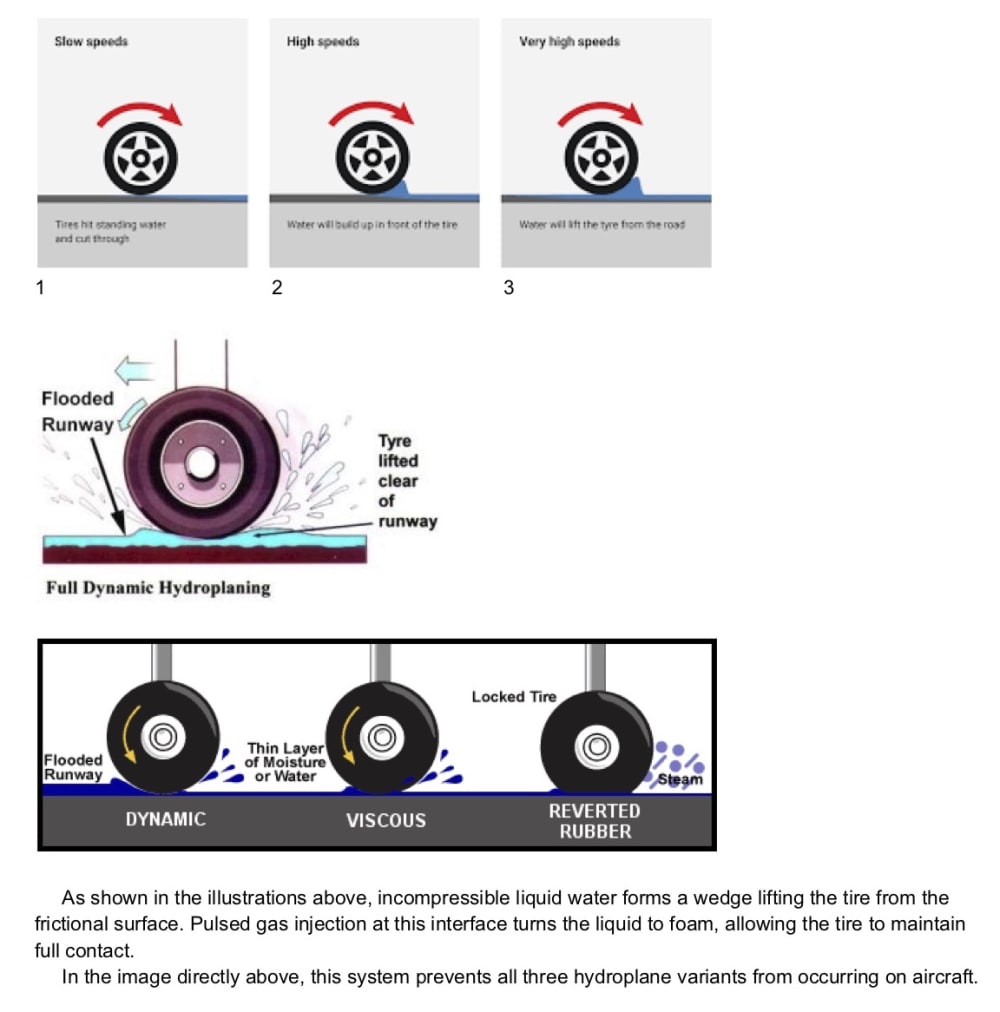OVERVIEW
This system works by disrupting the surface tension of water that 1, forms a wedge under a tire due to a combination of velocity and water depth on the road/runway surface (Dynamic Hydroplaning) and 2, aerosolizing the thin layer of water on oil film that forms on paved surfaces due to rubber deposited by tire contact and spin up. This is typically found near paved runway thresholds - the touchdown zone.
The system utilizes pulsed high pressure gas (nitrogen in aircraft use) sent through a pattern of orifices directed in front of the front tires (in a land based vehicle) and in front of the leading tires in the case of an aircraft landing gear bogie.
The use of sequenced pulsed nitrogen (or other appropriate gas) acts to essentially turn the water into foam, negating its ability to lift the tire from the road/runway surface.
The novel and unique part of this system is the use of “air bullets.” These are pulsed units of gas that are passed through an internally twisted orifice and, due to the imparted spin and velocity of the gas, impart a highly localized disruption of water tension. This essentially turns the standing water to foam, allowing the tire to pass through unimpeded.
The unique advantages of this system are that it nearly eliminates foreign objects, broken pavement etc. from being ejected at velocity because of the highly targeted nature of the gas pulses and, in the case of aircraft, eliminates FOD damage to other aircraft and airport structures (lighting, etc.).
There are actually no manufacturing issues in the production of this system for aircraft or land based vehicles.
It consists of:
- a high pressure gas source - nitrogen in aircraft, compressed air or nitrogen in land vehicles
- a manifold with computer controlled variable pressure control, a flat (or compound curved as required)
- An enclosed gas jet panel with system controlled vortex generating orifices combined with flat orifices (air knives) to aid in targeting the pulsed gas
- A Raspberry Pi4 or equivalent(COTS product) controller for individual orifice sequencing and pressure using available sensors in aircraft and modern land vehicles.
The gas jet panels can be injection molded or carbon fiber, depending on requirements. The panels are sized as necessary to cover the width of the tire and +\- 10cm deep depending on use. These are relatively inexpensive to make.
This system is appropriate for nearly all vehicles that encounter rainy weather, aircraft or cars, trucks, and emergency vehicles.
What differentiates this system:
- It does not use a constant stream of compressed gas.
- It does not use aircraft compressor bleed air. Bleed air use would require extensive plumbing, necessitate additional maintenance, and negatively impact turbine efficiency.
- It is compact and relatively inexpensive.
- It can also easily be retrofitted and also incorporated into the production process.
Like this entry?
-
About the Entrant
- Name:James Collins
- Type of entry:individual
- Patent status:none

